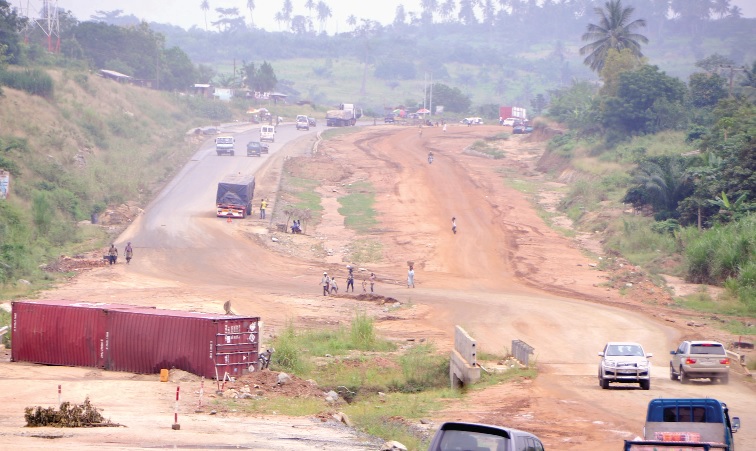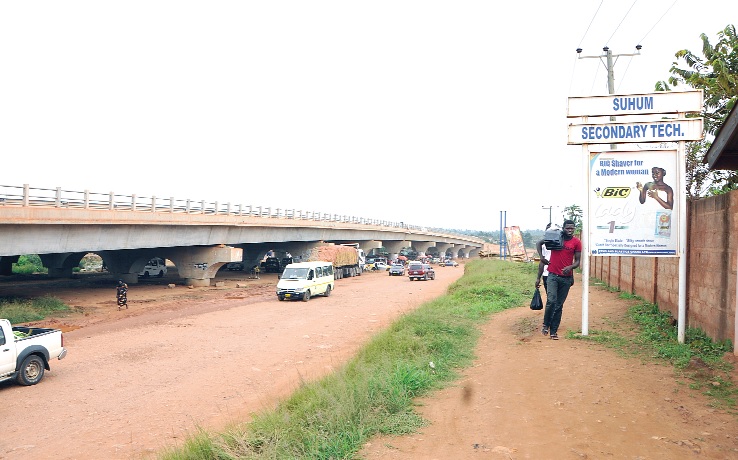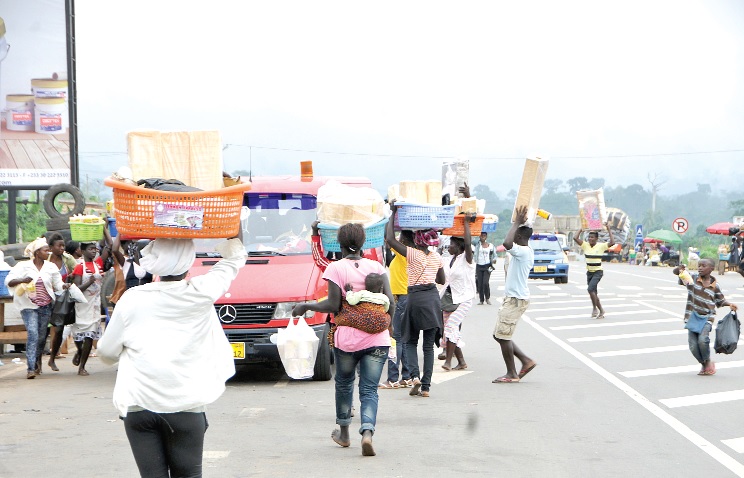The Accra-Nkawkaw Road -The pleasure, the frustration
 Frustration! That may be a perfect description of travelling experience on the Accra-Nkawkaw Highway, arguably the busiest road in Ghana, which connects the two largest cities in the country – Accra and Kumasi.
Frustration! That may be a perfect description of travelling experience on the Accra-Nkawkaw Highway, arguably the busiest road in Ghana, which connects the two largest cities in the country – Accra and Kumasi.
Advertisement
Although the reconstruction of the road started five years ago and has so far spanned three administrations – Kufuor, Mills and Mahama – there is no clue as to when it will be completed.
The concern of the thousands of drivers, passengers and pedestrians who use the highway on a daily basis has to do with its bad nature and their unanimous wish is for the government to fix it immediately.
But that wish may remain so for a long time because reconstruction work on the highway has been abandoned for now.
And so drivers and passengers may have to endure the frustration of travelling on the highway into the unforeseeable future.
When a Daily Graphic team undertook an Accra-Nkawkaw-Accra trip on the road last Saturday, July 20, 2013, there was no sign of work going on.
Indeed, construction vehicles and equipment were not on site, as is normally the case with road construction projects.
The road project
About a decade ago, travelling on the Accra–Nkawkaw Highway was a nightmarish experience, considering the bad nature of the road, particularly the Nsawam–Apedwa stretch.
It was, therefore, welcome news to drivers and passengers who travel on the road regularly when former President J. A. Kufuor cut the sod on Wednesday, October 15, 2008 to signify the beginning of reconstruction work on the Nsawam–Apedwa stretch.
The 31.7-kilometre road reconstruction project, estimated to cost GH¢158 million at that time, was being executed by a Chinese construction firm, Messrs China International Water and Electric Corporation.
It involved the reconstruction of the road into a dual carriageway, with asphalt concrete surfacing and an interchange at Suhum.
Originally, it was scheduled to be completed within 39 months, meaning by December 2011, the project should have been completed.
Many people heaved a great sigh of relief, as bulldozers and earth-moving machines began rolling and portions of the road started taking a modern shape.
But 20 months after the completion deadline in December 2011, the project has been abandoned for lack of money, leaving large portions of the Nsawam–Apedwa stretch in a more deplorable state than they were before the reconstruction work started.
Making road transport a pleasureable endeavour:
The good
The Nsawam–Apedwa stretch of the highway was part of the government’s programme under the Kufuor administration to modernise and transform the 245-kilometre Accra-Kumasi Highway into a dual carriageway.
The programme, which was to be executed in 10 phases, included the Kwame Nkrumah Circle-Achimota, Achimota-Ofankor, Ofankor-Nsawam, Apedwa-Anyinam, Anyinam-Nkawkaw, Nkawkaw-Asankare and Asankare-Duampompo stretches of the highway.
It also involved the construction of an interchange in Suhum and three by-passes in Nsawam, Nkawkaw and Konongo.
The good thing now is that the completion of the Achimota–Ofankor stretch and the Nsawam and Nkawkaw by-passes, has considerably eased traffic on the highway.
Hitherto, the traffic at Achimota, Nsawam and Nkawkaw was very terrible, given the narrowness of the road and the fact that the road passed through the busy commercial towns of Nsawam and Nkawkaw.
Many commercial drivers are now excited about the construction of the by-passes in Nsawam and Nkawkaw, describing them as a big relief to the travelling public along the route.
Kwabena Asubonteng, aka Bayano, a 207 Benz bus driver at the Neoplan Station in Accra, who plies the Accra–Kumasi route, said, “The by-passes are very helpful. I wish the road were a double lane from Accra to Kumasi.”
Richard Antwi, a Ford driver at the Neoplan Station in Accra, was also happy about the construction of the Nsawam and Nkawkaw by-passes, saying they were very good and beautiful.
The frustrations
But the beauty, smoothness and swiftness of the two by-passes are marred by the lack of streetlights, making their use at night rather unpleasant and unsafe.
That is a major concern for drivers and pedestrians who use the by-passes, as they appeal to the government to address the issue immediately.
“Even during day time, it is not safe to cross the road. So you can imagine attempting to cross it at night when there is no light and vehicles are speeding,” Adwoa Fosua, a hawker along the Nkawkaw by-pass, said.
For Joseph Pinkrah, who had bought a ticket at the VIP Station in Accra to travel to Kumasi, the lack of streetlights on the highway could be exploited by armed robbers to attack passengers travelling in the night.
Apart from the absence of streetlights that takes the shine off the Nkawkaw by-pass at night, the road could look more magnificent but for the unkempt inner island, portions of which have been turned into a farm with maize and other crops blossoming.
The stretch of the highway between Apedwa and the Bunso Junction was riddled with potholes at the time of travelling on it on Saturday, July 20, 2013.
Drivers at the VIP and the Neoplan stations in Accra alleged that the potholes along that stretch of the highway had resulted in many accidents, as drivers meandered their way through them.
“There is one big pothole near Bunso that has been there for about two years. It is very dangerous,” Kwaku Nsiah, a driver at the VIP Station in Accra, observed.
But his worries may be assuaged because the Daily Graphic team saw some workers of the Maintenance Unit of the Ghana Highway Authority (GHA) patching the potholes along the Apedwa–Bunso stretch.
The leader of the unit, Mr Edward Kwame Dotse, said it would take his men about two weeks to finish the patching on the estimated 20-kilometre stretch.
The ugly
The state of the Apedwa–Bunso stretch of the highway was very bad; but the situation was worse at Asuboi, Amanase, Okorase and Suhum.
Driving on those deplorable stretches of the road requires a great deal of patience, exceptional manoeuvring and steering dexterity.
Residents of communities nearby say during or after rainfall, many vehicles get stuck in the mud, and when that happens help is not immediately in sight.
The construction of a toll booth near Suhum has been abandoned, without warning signals, creating a death trap for motorists, especially at night.
According to Yaw Frimpong, a Ford driver at the Neoplan Station in Accra, some soldiers had crashed into the pillars of the abandoned toll booth recently, resulting in their death.
Rest stops
Apart from the Linda Dor Rest Stop, there is no rest stop along the Accra–Nkawkaw Highway worth the name.
The situation is posing great discomfort to both drivers and passengers who travel on the highway.
“Sometimes, you are compelled to stop along the road for somebody to urinate or attend to the call of nature. That is not the best. It can even be dangerous where the road is narrow. So we need many rest stops along the route,” Mr Kwaku Nsiah, a driver at the VIP Station in Accra, remarked.
But unlike male passengers who could just dash to a nearby bush and flip their zips open to discharge accumulated liquid in their bladders, those emergency stops along the road do not benefit female passengers, for obvious reasons.
The Daily Graphic team caught up with Grace Obenewa at the Linda Dor Rest Stop as she got down from a Kumasi-bound bus and she was not happy about the lack of rest stops on the highway.
“As females, we cannot urinate in the open and so we have to endure everything until we get to a rest stop like Linda Dor to do it. I don’t think this is the best,” she said.
Concerns of drivers
According to some commercial drivers who use the Accra–Nkawkaw Highway, the bad nature of the road is destroying their vehicles, adding that their expenditure on spare parts has increased drastically.
One major concern of the drivers is the number of speed humps constructed on the Nkawkaw by-pass.
In their opinion, the humps are too many and they destroy vehicles because some of the vehicles, especially the long buses, scratch over the humps sometimes.
“The humps are not helpful. They can cause accidents on the road,” Victor Kwarteng, an Accra-Kumasi bus driver at the Neoplan Station in Accra, submitted.
For Kofi Twumasi, a driver at the VIP Station in Accra, his concern was that portions of the highway were too narrow and they pose a major challenge to drivers of long vehicles, especially when they had to by-pass each other or disabled vehicles ahead.
He said the narrowness of the road at some portions was a major cause of accidents, adding, “Our leaders always travel abroad and see good roads but when they come back they don’t do the right thing.”
Another driver at the VIP Station, Kwaku Nsiah, is deeply concerned about disabled vehicles on the highway because they pose a great danger to safety.
He wondered why disabled vehicles were not towed away as early as possible to avoid accidents.
In the opinion of Isaac Boakye, a Ford driver at the Neoplan Station in Accra, the drainage systems along portions of the reconstructed roads were poorly done.
He said drivers must be consulted in the construction of roads so that they could share their experiences with contractors to enhance the quality of work done.
 Concerns of traders
Concerns of traders
In Nsawam and Nkawkaw, the hawkers are not enthused about the beauty or finesse of the by-passes off the two towns.
That is because the diversion of the road from the two towns has badly affected their businesses in respect of patronage.
Hitherto, the hawkers took advantage of the traffic situation in Nsawam and Nkawkaw to do brisk business, as travellers heavily patronised their goods.
“Now the vehicles don’t pass through here and so nobody is buying our things,” Akos, a seller of fried turkey tail or ‘Tsofi’, complained.
In Nkawkaw, the hawkers are calling for the installation of traffic lights at the junction where the new by-pass diverts from the old road leading to the town.
“The vehicles don’t stop here as much as we want. And so bringing traffic lights here will compel the vehicles to stop to enable us to sell our goods,” Ofori Kwame said.
Another hawker, Efia Pokua, said, “We’ve been running too much but the cars don’t move slowly. So we need traffic lights here.”
After making the approximately seven-hour return journey on the Accra-Nkawkaw Highway, the comments, views and concerns expressed by drivers, passengers and pedestrians could be summed up in a question posed by Yaw Frimpong, a Ford driver at the Neoplan Station in Accra: “When will this road be completed?”
By Kofi Yeboah/Ghana
Writer’s Email: [email protected]



